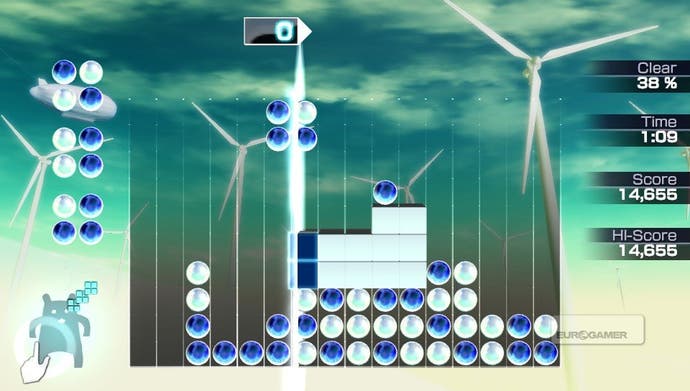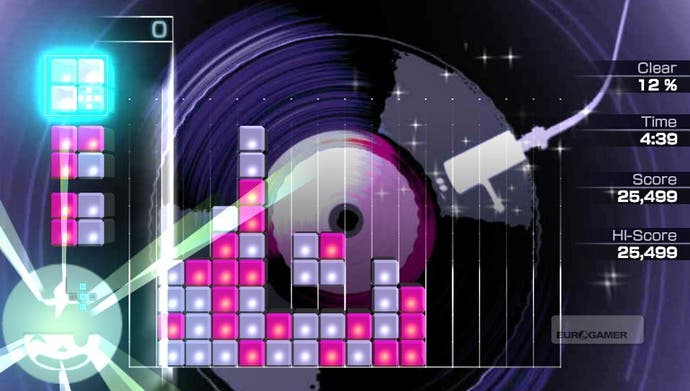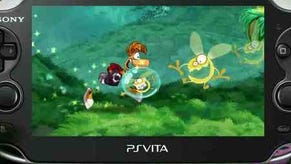Lumines Vita Preview: History Repeating
Is Electronic Symphony the first true sequel to the PSP's best launch game?
Lumines wasn't any old PSP launch title. It was the PSP launch title, and arguably the best pure puzzler since Tetris (a title it held onto until Drop 7 came along, of course). The synesthetic concerns of Q Entertainment, which first strutted along in ten-inch platforms in 2000's Space Channel 5 before taking a turn for the metaphysical in the following year's Rez, were melded perfectly with simple, grid-based puzzling. Like Rez before it, Lumines felt like a celebration of club culture - or, with its lazy rhythms and ability to consume whole hours, more a celebration of post-club culture.
It was the launch title in part because of its brilliance, and in part through a lack of anything else worth getting particularly excited about. For a year at least, the PSP was a Lumines machine - a situation that, in light of the Vita's bustling launch line-up, is unlikely to be repeated this time out.
The years since have seen Lumines spread like a sweet virus, although its appeal has been watered down a little, its rhythms gradually becoming easier to resist. Sequel has piled upon sequel, and each new iteration has struggled to add much of substance to the original - which is always a problem when you get it so very, very right the first time around.

Lumines: Electronic Symphony is celebrating launching another of Sony's portables by trying its best to be, if not the most radically different of the various iterations, then at least the definitive one. The fundamentals haven't changed - and why should they? - with a series of two-by-two blocks made up of two different colours being combined and swept away by a beat that becomes ever more insistent.
Naturally, it sparkles on Sony's new hardware. Skins pulsate and dazzle a little brighter on the OLED screen, and it's already proved a decent match for touch controls on mobiles, an impression that the Vita version does little to sully.
Q has also had a crack at incorporating the Vita's networking abilities, although the results are admittedly a little half-hearted. Gifts such as avatars and re-skins can be exchanged through Near in a fashion reminiscent of Super Mario 3D Land, and elsewhere, in a touch seemingly inspired by Noby Noby Boy's player-assisted quest for the heavens, scores can be uploaded and accumulated with the combined efforts contributing to one ever-growing block.

Any attempts to embellish the mechanics are, thankfully, slight. There's an XP system, of course - this is 2012, after all - and it at least has the courtesy to justify its presence, presenting another gentle pull through the typically lengthy play sessions. Avatars also come with power-ups, enabled by stringing together combos and - in the one example we saw - introducing a chain block that eats through any deposited blocks. There's a new block, too: the shuffle randomizes any other blocks it comes in contact with, helping you back out of any sticky situations you may have cornered yourself into.
The additions are all minor enough not to jar, but together they help break up the rhythm of the game - as well as breaking the monotony that starts to seep in to extended sessions of block-dropping.
It's well stacked in terms of rhythms, too. Lumines: Electronic Symphony can boast what's perhaps the best soundtrack to have graced the series. Aphex Twin, LFO and 808 State mix in with Air, Benny Bennassi and Howard Jones in what is, whatever way you slice it, an eclectic mix. The contributions of Tetsuya Mizuguchi's own Genki Rockets are missed, as too are some of the more idiosyncratic selections of Lumines' past, but while it eats away a little at the heart of the game it's arguably a slicker package for its more commercial choices.
And the heart of Lumines is, importantly, still intact, beating at the same steady 4/4 that it always has. It's no longer the launch game for Sony's handheld, but it's one of the more robust links in what's become a very strong opening line-up.









